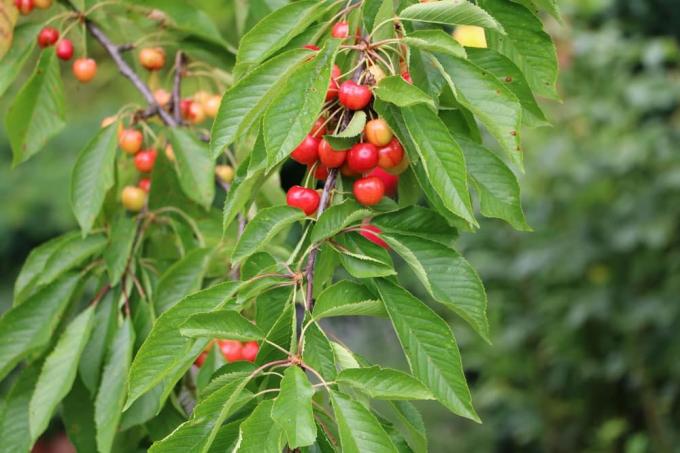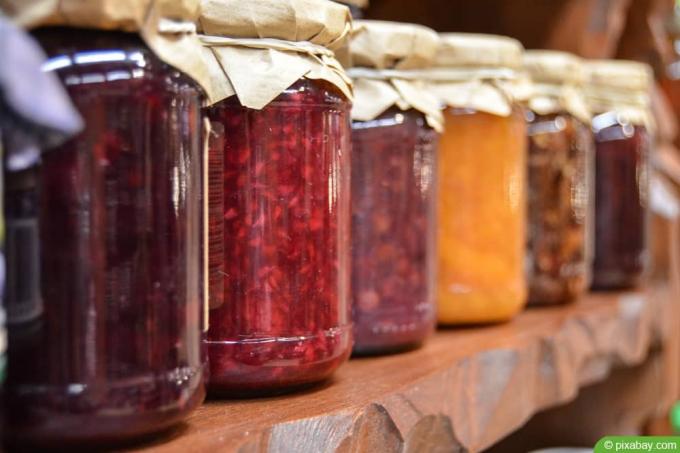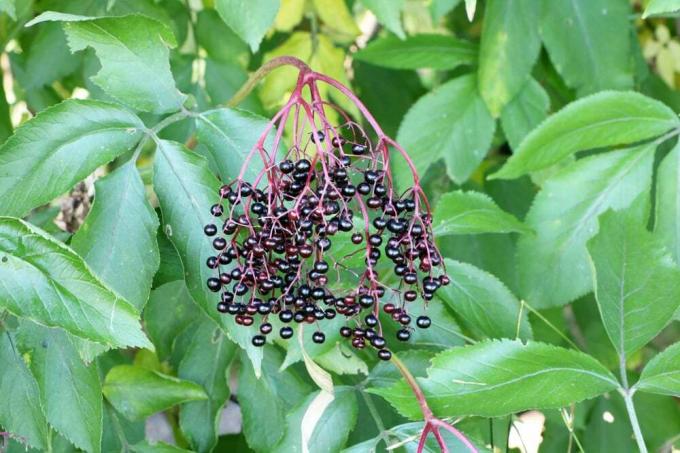

Table of contents
- basics
- The heating
- Cherries suitable for thickening
- coring
- Thicken with liquid
- Thicken cherries
- Classic variant
- Thicken with vanilla or cream pudding powder
- Thickening with gelling agents
- Thickened cherries with more aroma
Whether hot cherries on waffles, as a cake filling or on rice pudding, simply pouring cherries from the glass over does not serve the purpose of fruity refinement. To do this, cherries need to be thickened. There are a number of ways to thicken cherries. With the professional instructions, you can do it in no time at all.
basics
These things apply to all techniques for thickening cherries:
The heating
No matter which variant you choose to thicken cherries, the cherries must be heated in any case. Caution should be exercised in this regard. When the liquid has thickened, it will burn quickly. It is important to ensure that it is stirred constantly after thickening and while simmering. Once burned, a very unpleasant taste spreads throughout the whole lot. There is usually nothing left to save here, so that they are only enough for the garbage can.
Cherries suitable for thickening
In general, any type of cherry from sweet to sour can be used for thickening. Heart cherries, for example, are a very juicy variety, while whole-grain cherries have very firm flesh. Whether the cherries are frozen, fresh or from the jar is irrelevant. However, freshly harvested cherries turn out to be the crunchier ones. With the right approach, they usually retain significantly more "bite".
Cherries from the jar have the advantage that they bring the right liquid with them, which is needed for thickening. Frozen cherries tend to break down in structure and are very soft and can even become mushy if they take too long to thaw. For this reason, cherries from the freezer can always be used quickly and are less suitable for the sauce on waffles. As a fruit topping on a cake base or similar. As a cake layer, however, they are ideal to use.
coring
Before you can start thickening, remove the pits from the cherries. If they were to remain in the cherries, they would have a disruptive effect. In addition, they can come loose from the inside of the cherry when boiling and spread throughout the thickened mass, which prevents unrestricted consumption.
Thicken with liquid
With all variations of cherry thickening, the addition of liquid counts as one of the key ingredients. The fruity aroma is emphasized when you use kirsch. Cherries from the jar already contain this and should be collected for later use when the cherries are removed. If you would like to thicken fresh cherries, the easiest way is to use normal commercially available cherry juice as the liquid. But you can also press or mix a few cherries and make your own kirsch in this way.

Alternatively, conventional tap water can be used. However, this is tasteless and should only be chosen if other flavor nuances are added as a flavor additive or via the type of thickening. Otherwise the thickened cherry mass would taste too bland.
Thicken cherries
We show you the different ways to thicken cherries:
Classic variant
It is probably the oldest recipe for thickening cherries - with cornstarch. This was used in the past and can still be used today as potato or corn starch. The more starch you add, the thicker the kirsch becomes. The danger here is that too much cornstarch can only be lengthened again with difficulty. This means that once it is quite firm, it quickly clumps when liquid is poured into the hot pot. But even when mixing, a constant, even stirring process is required so that no lumps form. It is recommended to stir only small amounts of cornstarch into cold liquid. Many recipes detail how many tablespoons of cornstarch are required. Two tablespoons of cornstarch per cherry glass are usually sufficient.
If the consistency is still too thick during heating, stir a small amount of starch into significantly more cold liquid again and then mix it into the heated amount. This way you “elongate” the sauce while avoiding lumps forming.
How to thicken cherries with cornstarch:
- For soaked cherries: Put 350 grams of cherries (drained weight for glasses) in a saucepan with 1/2 liter of water/cherry juice
- heat pot
- For whole cherries: first thicken the liquid and finally fold in the cherries and heat briefly
- Stir about two tablespoons of cornstarch into some water/cherry juice
- For a firmer consistency, it should be about three to four tablespoons of cornstarch (e.g. for cake fillings)
- Slowly pour the mixture into the saucepan, whisking evenly, and mix in the water/cherry juice
- Bring to a boil
- If the consistency is not as desired, repeat the process with more or less cornstarch and add
- When the desired consistency is reached, remove the pot from the stove
- Serve/process hot or refrigerate to cool
Thicken with vanilla or cream pudding powder
In advance: Using custard to thicken it doesn't add a noticeable hint of vanilla to the whole. In this case, the pudding powder is primarily used to strengthen the consistency. If a vanilla flavor is desired, this should be added in a different form. The advantage of this thickening variant is that the consistency is always similar to that of a pudding. Here you cannot add too much or too little as long as you stick to the correct amount of liquid.
How to thicken with vanilla pudding:
- Heat 1/2 liter of cherry juice/water (with or without cherries – with the latter, the cherries are folded in after they have thickened so that they remain whole)
- Mix a package of custard powder with some cold liquid
- Slowly pour into the heated (cherry) water and stir continuously
- Bring to a boil, stirring constantly
- If necessary, add cherries and heat briefly
Tip:
Since the kirsch from a cherry glass is usually not enough, it can be mixed with water or conventional cherry juice to make up 0.5 liters of liquid. Milk is not suitable.
Thickening with gelling agents

If you want a fairly firm mass of hot cherries to spread on a cake, for example, thickening with gelling agents works best. These ensure that the thickened liquid does not run and, for example, flow down the edges of the cake. This is due to their ability to bind liquid.
The most common gelling agents include:
- glaze
- gelatin
- locust bean gum (suitable for vegans)
- Agar-Agar (vegan gelling agent made from dried seaweed)
How to thicken with gelatine and cake glaze:
- Stir a pack of gelatine or cake glaze into about 250 milliliters of warmed (cherry) water
- Boil briefly
- If you want the cherries to remain whole, put them in the pot just before boiling – otherwise add the liquid at the beginning
- Remove from the stove and process immediately while warm
How to thicken with locust bean gum and agrarian agrarian powder:
- Stir in one gram of locust bean gum per hundred milliliters of cold (cherry) water
- Alternatively, stir a teaspoon of ready-made agar-agar powder into 250 milliliters of cold liquid
- Cherries can be added before stirring or before boiling
- Boil briefly
- Ready for immediate further use on cakes or similar
Thickened cherries with more aroma
Depending on what you intend to do with the thickened cherries, you can add different flavors to them. If you like it sweet, you can add sugar before boiling. Children especially like cinnamon, which also provides a wintry aroma at Christmas time.
Hot cherries get a fresh touch with a dash of lemon juice. Rum or red wine can provide a special taste, especially for cakes and tarts. Almond liqueur can also be mixed in for a light nutty note, while a little orange liqueur in thickened cherries underscores the fruity aroma.
 garden editorial
garden editorial I write about everything that interests me in my garden.
Learn more about jams

Jam Labels: Free Labels & Vintage Templates
A jam jar looks much better with a pretty label. Whether you want to give it away or keep it for yourself, with a lovingly designed label, the jam in the jar looks even better. At the same time you know what is in the container and when it was boiled down. Something like that is also extremely important.

Cooking elderberry jam: recipes
A fruity and delicate jam can be made from elderberries, which is ideal as a sweet spread for breakfast or a snack. The berries, which grow wild in many places, are also suitable for making jelly, which scores with a particularly creamy taste.

Easy recipe for quince jelly
Are you lucky enough to have a quince tree in your garden? - Quinces not only have a particularly fine taste, they also contain a lot of healthy things. If your tree has a rich harvest in late autumn, you can prepare quince jelly.

Jam jar label ideas
A hobby gardener not only enjoys his well-kept garden paradise, but above all the fruits of his labor in the form of fresh fruit and berries. Jams are a popular way of using the harvested crop.

Make elderflower jam yourself
How often do we look forward to late spring or the beginning of summer about the splendor of white flowers with which the elder delights us. If you don't want to wait for the ripe berries, you can also use the flowers to make jam.

Make elderberry jam yourself
Elder trees and shrubs are common. They are not only at home in our gardens, they also grow in large numbers in the wild. The flowers, fruits and berries of the elder are popular. Learn more about recycling.
